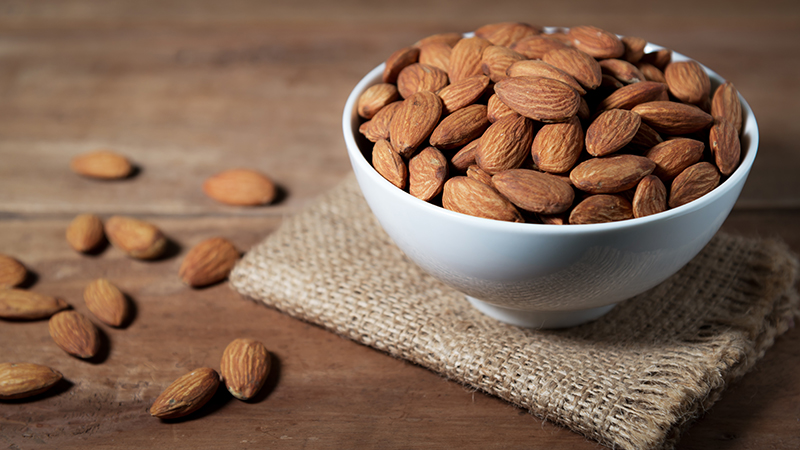AARP Eye Center
A Nutty Solution for Brain Health
By Candy Sagon, March 6, 2020 11:47 AM

Toss a handful of almonds or walnuts on your cereal or salad, mix some cashews into your dinner stir-fry or just munch some peanuts for a quick snack. It’s a daily habit that may be a key to supporting your brain health — and it may only take a couple of teaspoons.
A 2019 study by the University of South Australia of nearly 5,000 adults age 55-plus found that eating more than 2 teaspoons (10 grams) of nuts daily was linked with improved thinking, reasoning and memory.
Researchers found that those who ate more than 10 grams of nuts every day were 40 percent less likely to score low on mental skills tests compared with those who ate fewer nuts.
The study focused on older Chinese adults, analyzing their diets based on government data and measuring thinking skills over a nine-year period, but the findings are similar to a 2014 U.S. study of older women and a 2011 Dutch study of middle-aged men and women. Both of those studies also showed a connection between better brain function and eating nuts regularly.
In the U.S. study, which was based on data from the large, national Nurses’ Health Study, women 70 and older who ate 20 grams of nuts daily had better scores on memory and other cognitive tests than non-nut eaters.
China has one of the fastest growing aging populations, which is why the Australian researchers were interested in a possible link between nut consumption and staving off cognitive decline, said lead researcher Ming Li.
The research applies to other countries as well, she added. “Population aging is one of the most substantial challenges of the 21st century. Not only are people living longer, but as they age, they require additional health support, which is placing unprecedented pressure on aged-care and health services.”
This study, however, did not determine a cause for why nuts might affect the brain, only that the data found a connection between eating nuts and better brain health.
The researchers reported that peanuts were the most consumed by the study’s participants, but the adults in the study also said they ate walnuts and almonds, as well as sesame seeds, pumpkin seeds and sunflower seeds, which have similar nutrients to nuts.
To be strictly accurate, peanuts aren’t really nuts — they’re legumes — but nutritionally they’re very close, rich in unsaturated fat, folate, vitamin E, magnesium, potassium and fiber.
In the United States — perhaps because of the growing research about nuts’ health benefits — nut consumption has risen dramatically in the past decade, especially among older adults.
About 35 percent of adults ages 20 to 39 eat nuts on any given day, while among those 60 and over it was 42 percent, according to the latest government figures.
And while China leads the world in per capita consumption of peanuts, the United States ranks number 1 for munching on almonds, cashews and pecans.
In fact, since the 1970s — when nuts didn’t have their current health halo — Americans’ consumption of tree nuts has more than doubled, to 3.6 pounds per person in 2016, according to the U.S. Department of Agriculture. Almond consumption jumped the most, from about 4 ounces per person in 1970 to 1.6 pounds in 2016.
Florida dietitian Lauri Wright, who specializes in nutrition and aging and is a spokesperson for the Academy of Nutrition and Dietetics, says she regularly recommends nuts to her patients for their health benefits.
“Nuts contain a mix of monounsaturated and polyunsaturated fats that have been shown to help cognitive function and memory,” she said in an email.
“Nuts also improve your cholesterol levels and relax your blood vessels, both of which can lead to a stronger heart” and better blood flow to the brain.
Nuts are one of the foods encouraged by AARP’s Global Council on Brain Health report on “Brain Food,” although the report cautions that nuts are high in calories and so should be eaten in moderation.
For easy ways to add nuts to your diet, see the tips Wright offers her patients below.
What can you do?
- Aim for 1 ounce of nuts daily. That’s about 14 walnut halves, 24 almonds or 35 peanuts. An ounce supplies around 186 calories, 19 grams of fat and 4 grams of protein, Wright says. It also gives you more than 150 percent of the daily recommended amount for omega-3 fatty acids.
- Don’t worry so much about nuts’ calories and fat. Nuts can be higher in calories and fat, but they are a powerhouse of nutrients plus unsaturated fats that are good for the brain. A small daily portion is key.
- Try these easy additions. Swirl chopped nuts into your morning yogurt or oatmeal; spread nut butter on whole-grain bread at lunch; use crushed pecans to coat fish for dinner; add sautéed sliced almonds to green beans; carry premeasured portions of nuts or homemade trail mix in your car, purse or pocket for a nutritious snack.
This content is provided for informational purposes only and is not intended to provide any expert, professional or specialty advice or recommendations. Readers are urged to consult with their medical providers for all questions.























































